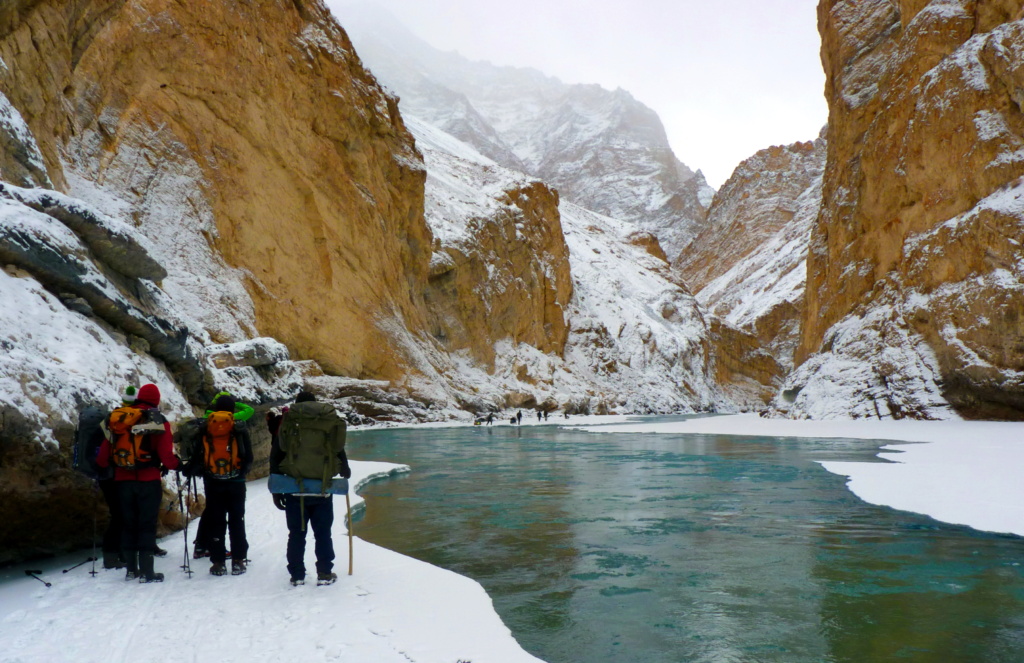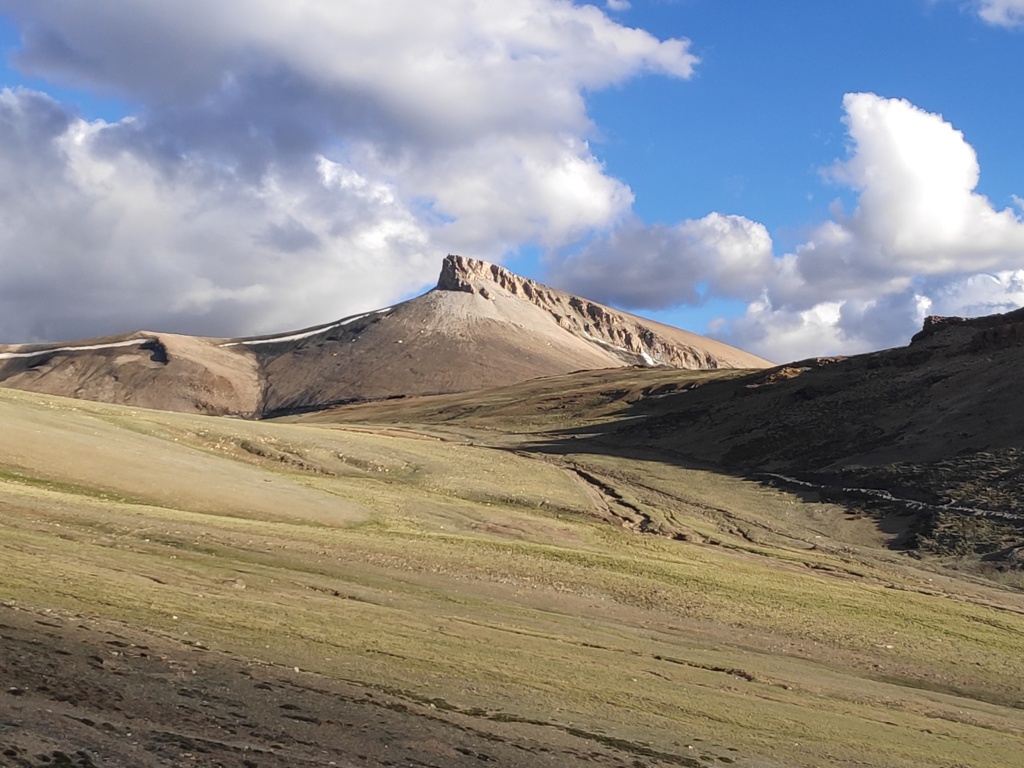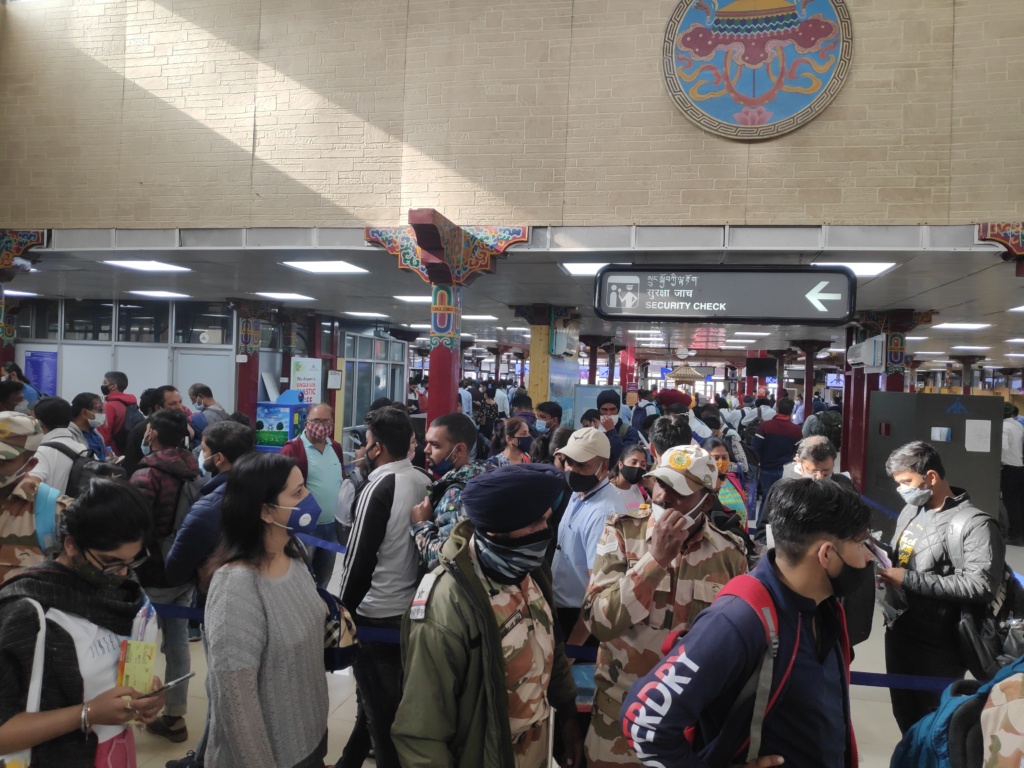Mass tourism has been a bone and a bane for the region. Alongside climate change, the future seems uncertain for this mountainscape.

Photo credit: Sumit Roy Dutta / Wikimedia Commons
First published: https://www.livemint.com/mint-lounge/features/is-ladakh-being-loved-to-death-11584165950939.html
Is Ladakh being loved to death?
Unsafe trekking trails, water stress and intense pressures on a fragile ecosystem are just some of the by-products of Ladakh’s embrace of unregulated tourism
In 2005, Rajat Jamwal had his first opportunity to lead a few clients up the frozen Zanskar river to the settlement of Padum. He hardly met anyone on the way, save the locals from Zanskar Valley who were headed to Ladakh to stock up on essentials for the winter. With the high passes leading in and out of Zanskar snowed in, walking along sections of the frozen river, called the Chadar (blanket), was their only access to the outside world, as has been the case through Zanskar’s history. By the end of the season, Jamwal had led around 18 trekkers across the Chadar, charging around ₹1.65 lakh per person for the two-week round trip.
These days, Jamwal has stopped operating on the route, for a number of reasons. The serene landscape is overrun by crowds of trekkers lumbering up the river. In places where the ice is weak or non-existent, there is a human traffic jam of sorts, until a route is forged along the steady slope that rises from the river. The campsites are packed to capacity, with limited dry land along the banks of the river to pitch tents. A nine-day trek is offered for as little as ₹19,500 per person by certain agencies, each one looking to make a quick buck, even as a road under construction threatens to bring an end to the renowned trek in a few years. According to the All Ladakh Tour Operators Association (Altoa), around 3,150 permits were issued in the 2019 season (the Chadar season runs through January and February).
“Once the trek gained popularity through the internet, it changed everything. We used to take shelter in caves, while these days there are tents put up everywhere to cater to the numbers. The prices have fallen as everyone wants business and the trek is being guided by unqualified people,” Jamwal says.
“There are fixed departures for these treks being planned as early as June, which means clients arrive on a certain date in January. How will you know the condition of the Chadar on this particular day so many months in advance?” he adds.
What used to be a six-month tourism season in Ladakh is today an year-long affair. Whilewildlife tourism in the winter has always had its takers, over the last few years the Chadar trek has brought in numbers that had rarely been seen earlier. Wasim Ahmad, owner of the Palace View Guest House in Leh, remembers that stay options were limited even a few winters ago. In fact, until 2010, his own establishment would be shut in winter.

Photo credit: Shail Desai
Even today, locals usually move out of Ladakh to escape the bitter freeze. But with business coming in, Ahmad says over 10 guest houses are open in Leh in winter, while he too has rented out two additional properties to cater to visitors, besides signing up with travel aggregators in 2018 to tap into the market.
By the time the 2020 season on the Chadar came to an end, Altoa had issued 2,288-odd permits to 68 operators. Apart from trekking charges—which depend on the operator—each trekker pays ₹5,000, which includes a wildlife fee, charges for insurance and rescue, medical check-up and clearances from Altoa. Trekkers must also acclimatize in Leh for three days, undergo a health check and obtain a permit before embarking on the trek.
“We issue only 100 permits each day, since there is limited capacity on the Chadar. This is under the new standard operating procedures implemented last year,” says Tsetan Angchuk, Altoa president.
“We have Ladakhi mountain guides and officials from the state disaster response force at each camp who are in charge of checking conditions of the Chadar and rescue operations. There are also army and civilian doctors who attend to emergencies,” he adds.
However, those who traversed the Chadar this year believe that the state of affairs leaves plenty to be desired. Unstable ice in certain sections resulted in over a hundred trekkers getting stranded at the beginning of the season, in January. They had to be airlifted to Leh. Some claim that the mandatory medical checks involved faulty, inaccurate devices and that more permits than allowed each day were issued. And sheer numbers are spoiling the pristine surroundings.
“The fabricated toilets at each camp have not been maintained. The ropes used to secure the patchy sections are of poor quality. People are coming unprepared and, in turn, it is the Armed Forces that are being misused for rescues. You don’t get anything in return for the money that you pay to buy the permit,” says Keval Kakka, who was guiding on the Chadar this season.
The tourist rush
The Chadar trek is a microcosm of Ladakh. What was once a region known for its serenity and solitude is today better known for the hordes of tourists who have put severe strain on Leh and other popular spots in the vicinity. For instance, trekkers weren’t allowed to camp around the Pangong Tso—a gigantic inland lake that is an important breeding area for waterfowl—around 2004; today, there is accommodation to suit every budget just 100m from the lake.
“In terms of geography and resource limitations, Ladakh is similar to Spiti in neighbouring Himachal Pradesh. The impetus on tourism in Ladakh, though, has brought in a new dimension by significantly adding to livelihood options,” says Ajay Bijoor of the Nature Conservation Foundation, whose research on man-animal conflicts has taken him to both regions.
Records from Ladakh Tourism reveal how dependent Ladakh has become on tourism over the years. In 1990, there were just 6,738 visitors (6,342 foreigners; 396 Indians); this rose to 18,055 (11,828 foreigners; 6,227 Indians) by 2000. In 2008, the figure climbed to 74,334 (35,311 foreigners; 39,023 Indians), with Indian tourists outnumbering foreigners for the first time. An astounding 327,366 tourists were registered in 2018. Last year saw 279,937 visitors despite the lockdown in Kashmir and a slowdown in the economy.

A new airport terminal, set to be constructed by September 2021, will only bring in more visitors, adding to the strain on resources and the ecosystem.
A walk around Leh in summer is a nightmare, with bumper-to-bumper traffic and water tankers parked outside properties to cater to tourists. Every second structure has been converted into, or has made way for, a guest house. There is unregulated digging of bore wells on private properties, and some have run dry due to overuse and a depleting water table. Traditionally, most Ladakhi homes used compost-pit toilets, which require no flushing, whereas the newer constructions are equipped with water tanks.
A number of local springs that communities depended on have also run dry.
“Water has become a huge problem in Leh, firstly because of the number of guest houses and hotels and the fact that tourists who are visiting aren’t necessarily sensitive to water consumption,” says Monisha Ahmed, executive director of the Ladakh Arts and Media Organization (Lamo), who has been working in the region for 30 years. In fact, a 2016 studyby Guru Balamurugan, Karthik Seshan and Somnath Bera from the Tata Institute of Social Sciences, says, “A huge demand of water supply requirement during the tourist season from May to September months and deficiency of water in the area (their study was conducted in the lower reaches of Leh valley) was calculated as 4,224,557 litres.”
Air quality around Leh too has gone downhill, with pollution increasing. Just a couple of kilometres outside Leh lies Bomgarh. Once a livestock pasture, it was converted into an army ammunition depot, and is now a large landfill. “The fires at this site choke the air in Leh since it is nearby and the wind carries plastic and pollutes the surroundings. It’s a nuisance,” says Tashi Morup, project director at Lamo.
During her study on waste and sustainability issues in Ladakh, National Geographic Explorer and Fulbright fellow Katie Conlon realized that there was a lack of decisive action on plastic. Although a ban had been imposed by the Women’s Alliance of Ladakh, an organization that works to preserve Ladakh’s traditional farming and culture, woven polythene bags that “look like cloth but are really plastic” continue to be used. According to her, in the tourist months, over 50,000 plastic bottles are used each day in Leh.
“Most people have little awareness of the effects of plastic dumped in the environment—like methane emissions, chemicals leaking into groundwater or the effect on animals. The food that comes in single-use packaging affects local agriculture, as there is no demand for traditional foods and crops. People who once practised sustainable living are buying into the culture of disposables and it is having an effect on their identity,” Conlon says.
It’s very common to see tourists at inland lakes like Pangong Tso and Tso Moriri in the Changthang region of Ladakh feeding potato chips to marmots, a small burrowing mammal. While this makes for “cute” photographs, the tourists are completely unmindful of the fact that they are interfering with the natural cycles of a wildlife habitat.
If you are crossing the wide, high-altitude grasslands of the nearby Morey Plains in Changthang, you will chance upon “intrepid” bikers off-roading across the undulating meadows. For Tsewang Namgail, director of the Snow Leopard Conservancy-India Trust (SLC-IT), in doing so, these tourists are destroying the burrows of several ground-nesting species. When Lounge spoke to him last year about aspects of tourism that worried him, he said: “Ground-nesting birds, lizards, small mammals like pikas are very important species that maintain the range plains. People say that Ladakh has a very fragile ecosystem, but many people don’t understand what that means. They think fragile means something that is easily breakable. What that means is that we have so few species that if one goes extinct, if one link is broken, then the whole thing just collapses.”
Climate change too has had its impact on the mountains of Ladakh. Research conducted by scientists A. Chevuturi, A.P. Dimri and professor R.J. Thayyen shows an increase in temperature and a change in precipitation patterns since the mid-1990s.
“Warmer air, due to increasing temperature trends, can hold higher amounts of moisture, which can lead to heavier rainfall for individual storms. Studies have shown that mountainous regions like the Himalayas warm more strongly than the global mean temperature. However, we need more scientific research to understand how the frequency and intensity of extreme precipitation will change over Leh in the warmer future,” says Chevuturi.
The warming conditions and the shift in precipitation patterns will have a significant impact on the environment and people of Ladakh. Like the flash floods in 2010, there might be an increase in the probability of extreme weather events in Leh, which could cause irreversible damage and lead to devastating consequences.
“When there are flash floods, a lot of water runs through landfills that have all kinds of hazardous waste from hospitals, construction sites, military bases and even e-waste. This is a toxic stew that contaminates soil and groundwater,” Conlon says. “The tourism industry is destroying the very thing that people go to Ladakh to see—the beautiful, serene Himalayas. Ladakh is being loved to death.”
Sustainable ventures
Though a collective effort is needed to overhaul the system, smaller initiatives are being attempted at the moment. Project Tsangda was started by the Ladakh Autonomous Hill Development Council and rural development department in December 2017 for the systematic disposal of garbage through community action. Over a thousand residents of Choglamsar, a village on the outskirts of Leh, have signed up as part of the project and segregate their garbage before handing it over for collection.
The dry waste is separated further at the project centre. Egg crates are used for sound-proofing, while Thermocol and paper bricks (made in-house) serve as insulation for homes. The biggest culprit, non-recyclable plastic, is used for road construction and to build boundary walls. The project has expanded to five other centres of Project Tsangda over the last year, including one each at Diskit in Nubra Valley and Pangong Tso.
“The Choglamsar centre is a self-sustainable model that is running on customer fees— ₹50 per household and ₹200 for commercial establishments. We have collected around 170,000kg over the last two years, most of which would have gone to landfills or been dumped in rivers and streams. Only 10% of our waste goes to landfills today,” says Yangchan Dolma, a supervisor at the solid resource management centre in Choglamsar.
For all the criticism that rampant tourism has drawn in Ladakh, there are a few examples of sustainable ventures as well. Alongside its conservation efforts, the SLC-IT runs wildlife tourism programmes, with locals being trained to track snow leopards and maintain homestays to the liking of guests, enabling extra income in the winters.
Nor can it be denied that tourism has brought prosperity to those in the sector. For instance, Wasim Ahmad can now regularly embark on international holidays during the lean period in March and couldafford an upgrade on his car as well as motorcycle. The profits from his business also allowed him to renovate the guest house in 2017.
Some communities, though, are taking the initiative to preserve their environment. Across the Indus from Leh, Stok Kangri (6,153m), the highest mountain in the Stok range, has been a popular trekking peak, but a receding glacier and activity higher up on the mountain left villagers in Stok village with contaminated water, which they use for everything from drinking to irrigation.
“Towards the end of last summer, the villagers put forward a proposal to stop all activity on the mountain until things got better. We spoke to the district administration and arrived at the decision to close the mountain for two seasons. At the end of 2021, we will take a call on reopening it based on the situation,” Angchuk says.
A lot will depend on how things pan out here on—the fate of Ladakh will lie in the hands of its own people. Take the Chadar trek, for example. The completion of an all-weather highway linking Nimmoo in Ladakh with Padum in Zanskar is still a few years away. Until the project is finished, the Chadar trek is likely to flourish, and the number of winter trekkers will keep rising.
For Namgail, safeguarding Ladakh’s unique environment ultimately depends on sensitizing locals. He says of the Chadar trek: “A lot of local travel agents, small travel agents, they want to make a quick buck and they don’t see any ecological implications or long-term impact, be it wildlife or environment. So rules might work in the short run, but soon it will fall back down to the ground if they don’t understand. But if they understand, then it might take some time, but slowly they will have self-regulating mechanisms.”
Right now, this remains Ladakh’s only hope.
With inputs from Bibek Bhattacharya.